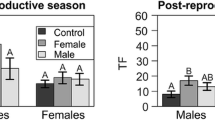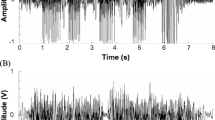Abstract
When choosing between two potential mates, a male may benefit by picking a larger (longer and/or more heavy-bodied) female because she is likely to produce more or larger offspring. Males of many species use visual cues to evaluate the sizes of their mates, but in some situations (at night or in a crowded mating swarm), vision may be useless. Potentially, males may be able to use chemical cues that convey information about female body size. We manipulated cues available to free-ranging male garter snakes (Thamnophis sirtalis parietalis) in large courting aggregations near communal dens in Manitoba, Canada. Males not only directed disproportionate courtship to longer and heavier-bodied females, but also courted most vigorously in response to lipids extracted from the skins of such females. Our data show that with a flick of his tongue, a male garter snake can identify not only a female's body length, but also her body condition.

Similar content being viewed by others
References
Andersson M (1994) Sexual selection. Princeton University Press, Princeton, New Jersey
Bonnet X, Naulleau G, Shine R, Lourdais O (2001) Short-term versus long-term effects of food intake on reproductive output in a viviparous snake Vipera aspis. Oikos 92:297–308
Brown WD (1990) Size-assortative mating in the blister beetle Lytta magister (Coleoptera:Meloidae) is due to male and female preference for larger mates. Anim Behav 40:901–909
Brown WD (1993) The causes of size-assortative mating in the leaf beetle Trirhabda canadensis (Coleoptera: Chrysomelidae). Behav Ecol Sociobiol 33:151–157
Clutton-Brock TH (1991) The evolution of parental care. Princeton University Press, Princeton, New Jersey
Devine MC (1977) Copulatory plugs, restricted mating opportunities and reproductive competition among male garter snakes. Nature 267:345–346
Dewsbury DA (1982) Ejaculate cost and male choice. Am Nat 119:601–610
Duvall D, King MB, Gutzweiler KJ (1985) Behavioral ecology and ethology of the prairie rattlesnake. Natl Geogr Res 1:80–111
Duvall D, Schuett GW, Arnold SJ (1993) Ecology and evolution of snake mating systems. In: Seigel RA, Collins JT (eds) Snakes: ecology and behavior. McGraw-Hill, New York, pp 165–200
Fitch HS (1970) Reproductive cycles in lizards and snakes. Univ Kansas Mus Nat Hist Misc Publ 52:1–247
Galvani A, Johnstone R (1998) Sperm allocation in an uncertain world. Behav Ecol Sociobiol 44:161–168
Gregory PT (1974) Patterns of spring emergence of the red-sided garter snake (Thamnophis sirtalis parietalis) in the Interlake region of Manitoba. Can J Zool 52:1063–1069
Gregory PT (1977) Life-history parameters of the red-sided garter snake (Thamnophis sirtalis parietalis) in an extreme environment, the Interlake region of Manitoba. Nat Mus Can Publ Zool 13:1–44
Gregory PT, Stewart KW (1975) Long-distance dispersal and feeding strategy of the red-sided garter snake (Thamnophis sirtalis parietalis) in the Interlake of Manitoba. Can J Zool 53:238–245
Halpern M, Kubie JL (1984) The role of the ophidian vomeronasal system in species-typical behavior. Trends Neurosci 7:472–477
Hawley AWL, Aleksiuk M (1976) Sexual receptivity in the female red-sided garter snake (Thamnophis sirtalis parietalis). Copeia 1976:401–404
LeMaster MP, Mason RT (2003) Evidence for a sex pheromone mediating mate choice in the red-sided garter snake, Thamnophis sirtalis parietalis. J Chem Ecol (in press)
LeMaster MP, Moore IT, Mason RT (2001) Conspecific trailing behavior of red-sided garter snakes, Thamnophis sirtalis parietalis, in the natural environment. Anim Behav 61:827–833
Mason RT (1993) Chemical ecology of the red-sided garter snake, Thamnophis sirtalis parietalis. Brain Behav Evol 41:261–268
Naulleau G, Bonnet X (1996) Body condition threshold for breeding in a viviparous snake. Oecologia 107:301–306
Olsson M (1993) Male preference for large females and assortative mating for body size in the sand lizard. Behav Ecol Sociobiol 32:337–341
Panhuis TM, Butlin RK, Zuk M, Tregenza T (2001) Sexual selection and speciation. Trends Ecol Evol 16:364–371
Rossman DA, Ford NB, Seigel RA (1996) The garter snakes: evolution and ecology. University of Oklahoma Press, Norman, Oklahoma
Sandler B, Nikonova L, Leal W, Clardy J (2000) Sexual attraction in the silkworm moth: structure of the pheromone-binding-protein-bombykol complex. Chem Biol 7:143–151
Schwagmeyer PL, Parker GA (1990) Male mate choice as predicted by sperm competition in thirteen-lined ground squirrels. Nature 348:62–64
Seigel RA, Ford NB (1987) Reproductive ecology. In: Seigel RA, Collins JT, Novak SS (eds) Snakes: ecology and evolutionary biology. Macmillan, New York, pp 210–252
Shetty S, Shine R (2002) The mating system of yellow-lipped sea kraits (Laticauda colubrina, Laticaudinae). Herpetologica 58:170–180
Shine R, Mason RT (2001) Courting male garter snakes use multiple cues to identify potential mates. Behav Ecol Sociobiol 49:465–473
Shine R, Olsson MM, Mason RT (2000a) Chastity belts in gartersnakes: the functional significance of mating plugs. Biol J Linn Soc 70:377–390
Shine R, O'Connor D, Mason RT (2000b) Female mimicry in gartersnakes: behavioural tactics of "she-males" and the males that court them. Can J Zool 78:1391–1396
Shine R, Elphick MJ, Harlow PS, Moore IT, LeMaster MP, Mason RT (2001a) Movements, mating and dispersal of red-sided gartersnakes from a communal den in Manitoba. Copeia 2001:82–91
Shine R, O'Connor D, LeMaster MP, Mason RT (2001b) Pick on someone your own size: ontogenetic shifts in mate choice by male garter snakes result in size-assortative mating. Anim Behav 61:1133–1141
Tirindelli R, Mucignat-Caretta C, Ryba N (1998) Molecular aspects of pheromonal communication via the vomeronasal organ of mammals. Trends Neurosci 21:482–486.
Whittier JM, Mason RT, Crews D (1985) Mating in the red-sided gartersnake, Thamnophis sirtalis parietalis: differential effects on male and female sexual behavior. Behav Ecol Sociobiol 16:257–261
Acknowledgements
We thank D. Roberts, A. Johnson, G. Johnson, and R. Nesbitt for help and encouragement. Financial support was provided by the Australian Research Council, the National Science Foundation, and the Whitehall Foundation (W95–04). Research was conducted under the authority of Oregon State University Institutional Animal Care and Use Committee Protocol No. LAR-1848B. All research was conducted in accord with the U.S. Public Health Service Policy on Humane Care and Use of Laboratory Animals and the National Institutes of Health Guide to the Care and Use of Laboratory Animals, and conforms to all current Canadian laws.
Author information
Authors and Affiliations
Corresponding author
Additional information
Communicated by W.E. Cooper
Rights and permissions
About this article
Cite this article
Shine, R., Phillips, B., Waye, H. et al. Chemosensory cues allow courting male garter snakes to assess body length and body condition of potential mates. Behav Ecol Sociobiol 54, 162–166 (2003). https://doi.org/10.1007/s00265-003-0620-5
Received:
Revised:
Accepted:
Published:
Issue Date:
DOI: https://doi.org/10.1007/s00265-003-0620-5




